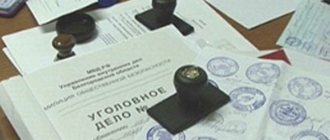In order for the evidence that must be compiled by the investigator on the basis of materials provided to him by the body carrying out the operational investigative activity to meet the requirement of admissibility, first of all, the procedure prescribed by law for attaching materials obtained through operational investigative means to the criminal case must be observed. Currently, this procedure is established by the “Instruction on the procedure for presenting the results of operational investigative activities to the body of inquiry, investigator or to the court”, approved by orders of the Ministry of Internal Affairs of Russia No. 776, Ministry of Defense of Russia No. 703, FSB of Russia No. 509, FSO of Russia No. 507, FCS of Russia No. 1820, SVR of Russia No. 42, FSIN of Russia No. 535, FSKN of Russia No. 398, IC of Russia No. 68 dated 09.27.2013.
I would not be opening America if I said that nowadays crimes are almost never solved solely through investigative methods. As a rule, one way or another, investigators are forced to use the results of operational investigative activities both as grounds for initiating a criminal case and in proving them. This possibility, in particular, is directly mentioned in Art. 89 of the Code of Criminal Procedure of the Russian Federation and Article 11 of the Law on Operational Investigations.
Here it is appropriate to recall the provisions of Art. 50 Constitution of the Russian Federation, Art. 7, 75 and 89 of the Code of Criminal Procedure of the Russian Federation. In particular, we are talking about the fact that if evidence was obtained in violation of the requirements of federal laws, it must be declared inadmissible with all the ensuing consequences.
The question arises: what does the investigator need to do to ensure that the evidence that he must form on the basis of the materials provided to him by the body carrying out the operational investigation meets the admissibility requirement?
The answer is obvious. First of all, the procedure prescribed by law for attaching materials obtained through operational investigative methods to a criminal case must be observed.
This is the order we will talk about.
Investigative actions based on the results of the operational investigation
If the information in the report or message provided by the investigators has a complete list of well-founded evidentiary arguments for the continuation of criminal procedural measures, the investigator, in turn, begins to put into effect his official guidelines on the fact of working to solve the criminal case.
- The procedure for detaining a suspect - during investigative measures, in accordance with the regulations of the Code of Criminal Procedure, a search and possible examination of the potential object of the crime is carried out.
- Seizure of objects connected to the case - the seizure and inspection of things, clothes, shoes and other items that belong to the suspect are carried out.
- Sending potential material evidence for examination - all the same items from the suspect’s personal wardrobe, his household or work equipment, things that can help clarify the circumstances of a crime committed or just being prepared - all this is subject to laboratory analysis.
- Conducting interrogation - in accordance with current legislation, the suspect himself and potential accomplices or other participants in search activities are subject to mandatory interrogation in order to identify their involvement in the crime committed.
- Identification procedure - if necessary, witnesses in the case can identify the suspect during investigative measures. In such cases, non-visual observation of the suspect by an identifiable person is possible in order to maintain his safety as a witness.
- Viewing and listening to recordings on appropriate media - evidence may be added to the case in the form of certain videos, audio recordings and photographs depicting the fact of an offense committed by the suspect.
- Search - the investigative committee receives permission to search the suspect’s work or living quarters in order to find out additional specifics of the circumstances of the crime committed by the potential criminal.
Upon completion of investigative activities, evidence obtained during investigative activities, along with the findings of the task force, is transferred to the prosecutor’s office and judicial proceedings.
Types of information taken into account based on the results of operational activities
All information that is covered by the operative in the report in accordance with the Instructions on the presentation of the results of operational investigative activities is conditionally divided into three main types:
- Information about persons (suspects) who are preparing, committing or have already committed an atrocity, who are hiding from operatives and investigative bodies, trying to avoid investigation and trial and thus evading criminal punishment. It also provides information about missing persons, persons involved in the case and unidentified corpses.
- Information about events and facts that indicate a threat of a state, military, economic and environmental nature to the security of Russia. This includes information about aspects of recorded solved and unsolved crimes.
- Information about objects - this means a list of all possible objects that are directly related to the commission of a crime. These can be murder weapons, firearms and bladed weapons, vehicles used to transport a hostage, victims, as well as all sorts of things used by the suspect or related to the victim at the time the crime was committed.
Conditions for the results of operational investigations to become legally justified
In order for the above-mentioned items of seizure or seizure in the form of direct or indirect information carriers to become evidence, it is not enough to simply take them and attach them to the case, without good reason. What conditions govern the procedure for establishing the results of operational investigative activities as significant evidence?
- Firstly, this kind of results of operational activities must be a consequence of the implementation of the actions of operatives directly disclosed in Art. 6 of the Law “On Operational Investigations”.
- Secondly, the measures themselves must be carried out by none other than the relevant authorized bodies (operatives) in a mandatory manner provided for by the current legislation of the Russian Federation.
- Thirdly, all kinds of physical evidence must be documented.
Significance of the ORD results
The implementation of operational-search activities is carried out by law enforcement agencies in order to identify the facts of a crime and collect information to ensure the subsequent punishment of those responsible for the crime committed. One way or another, their work, as an activity to protect rights and protect the life of society, is aimed at ensuring conditions under which justice is subsequently done in legal proceedings. At the same time, the results of the operational investigation are the core link in the process of informative support of the investigative process. They make it possible to identify specific objects of search in a certain place and time, determine the real need and expediency of the objective focus of operational impact on them, predict the results of this impact, select appropriate measures, means, techniques, areas of activity, etc.
Today, the idea of actively using the results of operational investigations in proving is reflected in practice, where these results are often given the importance of forensic evidence. They contribute to the formation of a legislative framework that is capable of satisfying the need of legal proceedings for high-quality, reliable, complete and truthful information in accordance with the norms established by law. Thanks to the activities of the employees of the operational department and the results of their work, the information they received during their work makes it possible for the investigation to carry out investigative and operational measures to solve criminal offenses as quickly as possible, followed by proof of the guilt of the criminals in court and the imposition of an appropriate sentence on them.
Source
Documentation confirming the authenticity of the origin of the results of the operational investigation
You may be interested in: Benefits of an orphan.
Federal Law “On additional guarantees for social support of orphans and children left without parental care” dated December 21, 1996 No. 159-FZ In terms of conducting operational search activities, operatives often have to seize various items that are directly related to the case to it and carrying the evidentiary nature of a particular fact. The very moment of receipt of such items by operatives is documented, and within the official jurisdictional powers of the employee, such recording often takes the form of a protocol. It could be:
- inspection protocol;
- arrest report;
- seizure protocol;
- protocol of voluntary extradition, etc.
In this case, the following sources can serve as evidence confirming the origin of a substance or object obtained during operational search activities:
- documentation through which the results of the relevant search actions were documented (all the same protocols, as well as papers on administrative detention);
- a message (covering letter) and a resolution on the transfer of materials of operational work to the investigation for their further inclusion in the criminal case;
- documented testimony of the participants involved in the case regarding the circumstances of the crime they contemplate.


